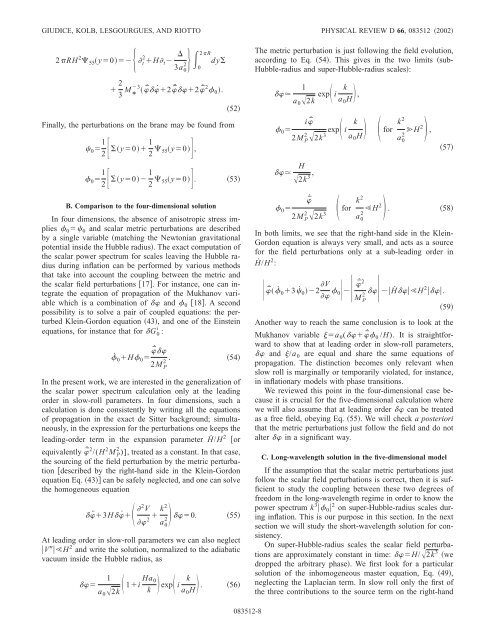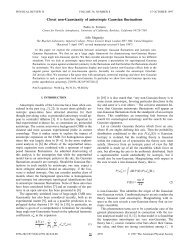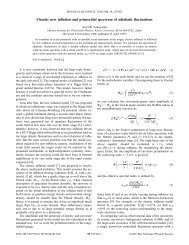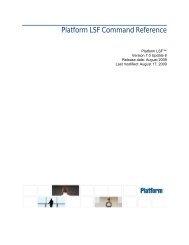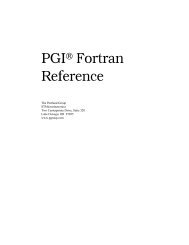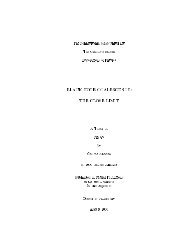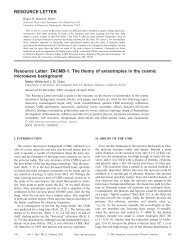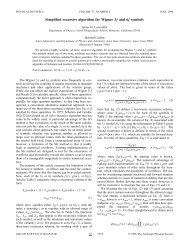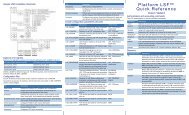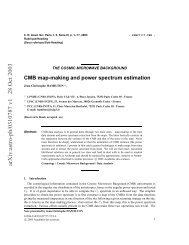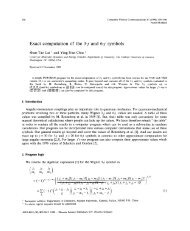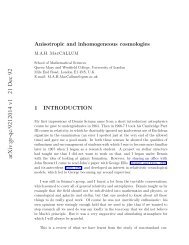Transdimensional physics and inflation - American Physical Society
Transdimensional physics and inflation - American Physical Society
Transdimensional physics and inflation - American Physical Society
Create successful ePaper yourself
Turn your PDF publications into a flip-book with our unique Google optimized e-Paper software.
GIUDICE, KOLB, LESGOURGUES, AND RIOTTO<br />
2RH 2 55 y0 t 2 H t <br />
3a 0<br />
2<br />
0<br />
2R<br />
dy<br />
PHYSICAL REVIEW D 66, 083512 2002<br />
The metric perturbation is just following the field evolution,<br />
according to Eq. 54. This gives in the two limits sub-<br />
Hubble-radius <strong>and</strong> super-Hubble-radius scales:<br />
2 3 M 3 ¯˙ ˙ 2¯¨ 2¯˙<br />
*<br />
2 0 .<br />
52<br />
Finally, the perturbations on the brane may be found from<br />
0 1 2<br />
y0 1 2 55y0,<br />
1<br />
a 0<br />
<br />
2k exp i<br />
k<br />
,<br />
a 0 H<br />
i¯˙<br />
0 <br />
2<br />
2M P2k exp i<br />
3<br />
k<br />
a 0 H<br />
H2 k2<br />
for ,<br />
2<br />
a 0<br />
57<br />
0 1 2<br />
y0 1 2 55y0.<br />
B. Comparison to the four-dimensional solution<br />
53<br />
In four dimensions, the absence of anisotropic stress implies<br />
0 0 <strong>and</strong> scalar metric perturbations are described<br />
by a single variable matching the Newtonian gravitational<br />
potential inside the Hubble radius. The exact computation of<br />
the scalar power spectrum for scales leaving the Hubble radius<br />
during <strong>inflation</strong> can be performed by various methods<br />
that take into account the coupling between the metric <strong>and</strong><br />
the scalar field perturbations 17. For instance, one can integrate<br />
the equation of propagation of the Mukhanov variable<br />
which is a combination of <strong>and</strong> 0 18. A second<br />
possibility is to solve a pair of coupled equations: the perturbed<br />
Klein-Gordon equation 43, <strong>and</strong> one of the Einstein<br />
equations, for instance that for G 0 i :<br />
˙ 0H 0 ¯˙ <br />
2M P<br />
2 .<br />
54<br />
In the present work, we are interested in the generalization of<br />
the scalar power spectrum calculation only at the leading<br />
order in slow-roll parameters. In four dimensions, such a<br />
calculation is done consistently by writing all the equations<br />
of propagation in the exact de Sitter background; simultaneously,<br />
in the expression for the perturbations one keeps the<br />
leading-order term in the expansion parameter Ḣ/H 2 or<br />
equivalently ¯˙ 2 /(H 2 M 2 P )], treated as a constant. In that case,<br />
the sourcing of the field perturbation by the metric perturbation<br />
described by the right-h<strong>and</strong> side in the Klein-Gordon<br />
equation Eq. 43 can be safely neglected, <strong>and</strong> one can solve<br />
the homogeneous equation<br />
¨ 3H˙ 2 V<br />
0. 55<br />
2 k2<br />
a 0<br />
2<br />
At leading order in slow-roll parameters we can also neglect<br />
VH 2 <strong>and</strong> write the solution, normalized to the adiabatic<br />
vacuum inside the Hubble radius, as<br />
1<br />
a 0<br />
1i Ha 0 k<br />
2k k<br />
exp i . 56<br />
a 0 H<br />
<br />
H<br />
2k , 3<br />
¯˙<br />
0 <br />
2<br />
2M P2k 3<br />
H2 k2<br />
for .<br />
2<br />
a 0<br />
58<br />
In both limits, we see that the right-h<strong>and</strong> side in the Klein-<br />
Gordon equation is always very small, <strong>and</strong> acts as a source<br />
for the field perturbations only at a sub-leading order in<br />
Ḣ/H 2 :<br />
¯˙ ˙ 03˙ 02 V<br />
0 ¯˙ 2<br />
M P<br />
2 ḢH2 .<br />
59<br />
Another way to reach the same conclusion is to look at the<br />
Mukhanov variable a 0 (¯˙ 0 /H). It is straightforward<br />
to show that at leading order in slow-roll parameters,<br />
<strong>and</strong> /a 0 are equal <strong>and</strong> share the same equations of<br />
propagation. The distinction becomes only relevant when<br />
slow roll is marginally or temporarily violated, for instance,<br />
in <strong>inflation</strong>ary models with phase transitions.<br />
We reviewed this point in the four-dimensional case because<br />
it is crucial for the five-dimensional calculation where<br />
we will also assume that at leading order can be treated<br />
as a free field, obeying Eq. 55. We will check a posteriori<br />
that the metric perturbations just follow the field <strong>and</strong> do not<br />
alter in a significant way.<br />
C. Long-wavelength solution in the five-dimensional model<br />
If the assumption that the scalar metric perturbations just<br />
follow the scalar field perturbations is correct, then it is sufficient<br />
to study the coupling between these two degrees of<br />
freedom in the long-wavelength regime in order to know the<br />
power spectrum k 3 0 2 on super-Hubble-radius scales during<br />
<strong>inflation</strong>. This is our purpose in this section. In the next<br />
section we will study the short-wavelength solution for consistency.<br />
On super-Hubble-radius scales the scalar field perturbations<br />
are approximately constant in time: H/2k 3 we<br />
dropped the arbitrary phase. We first look for a particular<br />
solution of the inhomogeneous master equation, Eq. 49,<br />
neglecting the Laplacian term. In slow roll only the first of<br />
the three contributions to the source term on the right-h<strong>and</strong><br />
083512-8


